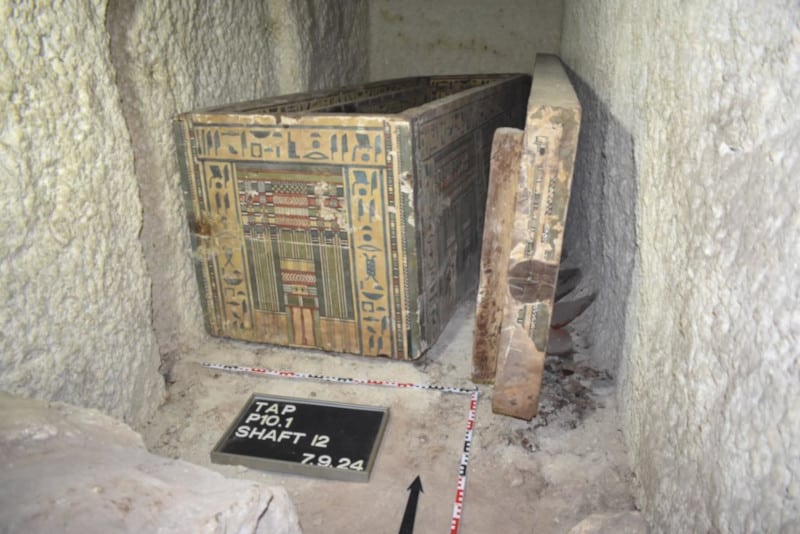
Photo: Susen Döbel, © Jochem Kahl, The Asyut Project
Archeologists have made a thrilling discovery in Egypt—one that has been twenty years in the making. The burial chamber of an ancient Egyptian priestess was found in a previously inaccessible section of the necropolis of Asyut. The unusual intricacy of the objects unearthed there is offering researchers new insights about women in power and funeral rites.
The biggest findings are two richly decorated coffins made from imported wood that fit into each other. One is 7.5 feet long, while the other is 8.5 feet long. Both are covered in inscriptions that tell the life story of Idy, the priestess whom was buried here. Idy was a priestess of the goddess Hathor, who also held the honorific of “Lady of the House,” pointing to her prominent status. Beyond these personal details, the images also explain the journey of the dead into the afterlife. A chest containing canopic jars—which hold the vital organs that were removed during the mummification process, such as liver, spleen, lungs, and intestines—was also discovered on site.
The chamber was discovered behind a quarry stone wall at the bottom of a 45-foot deep vertical shaft in a previously inaccessible section of the rock-cut tomb of her father, Djefaihapi I. He was a high-ranking official and regional governor, and his burial complex was built around 1880 BCE, some 4,000 years ago. The site, located along the River Nile, has been undergoing excavations since 2003, while digging in the shaft where Idy’s chamber was found began only two years ago. According to the archeologists, Idy was about 40 years old when she died from unknown causes. The ornate burial site, alongside her titles, signal that she held some power in the ancient Egyptian court.
“Idy’s coffins and their decorations surpass contemporary objects through the artistry of their execution and thus seamlessly tie in with the outstanding quality of the texts and images in the tomb of her father Djefai-Hapi I,” shares Professor Jochem Kahl, an Egyptologist from Freie Universität Berlin who led the research. He further goes on to call the burial chamber’s discovery, “extraordinary, both aesthetically and scientifically.”
The burial site appeared to have been ransacked thousands of years ago, with robbers taking all jewelry and objects made of precious metal objects that are often found in graves of high-rank figures. Luckily, most of the burial goods, , such as wooden figurines, a dagger, pharaonic insignia, and food offerings, remained in place. Archeologists also found remnants of her bones and clothing in the chamber.
The research was led by Professor Kahl in cooperation with Sohag University (Egypt), Kanazawa University (Japan), and the Polish Academy of Sciences. After some initial conservation, the items were handed over to the Egyptian Ministry of Antiquities and Tourism.
The burial chamber of an ancient Egyptian priestess was found in a previously inaccessible section of the necropolis of Asyut, in Egypt.

Photo: Andrea Kilian, © Jochem Kahl, The Asyut Project.
The biggest finding are two richly decorated coffins covered in inscriptions that tell the life story of Idy, the priestess buried there, and explain the journey of the dead into the afterlife.

Photo: Susen Döbel, © Jochem Kahl, The Asyut Project.
Archeologists also found wooden figurines, a dagger, pharaonic insignia, and food offerings, which will be handed over to the Egyptian Ministry of Antiquities and Tourism.

Photo: Tina Beck-Hasselbach, © Jochem Kahl, The Asyut Project.

Photo: Fritz Barthel, © Jochem Kahl, The Asyut Project.
Source: Burial Chamber and Grave Goods of Ancient Egyptian Priestess Discovered in Asyut
Related Articles:
How Did Egyptians Build Pyramids? New Study Suggests Answer
Team of 30 Archaeologists Spend 5 Years Uncovering Ancient Egyptian New Year’s Painting
3,000-Year-Old Egyptian Coffin Includes Drawing That Looks Just Like Marge Simpson
Researchers Rediscover Lost Egyptian Tomb With 4,400-Year-Old Mummy Inside
